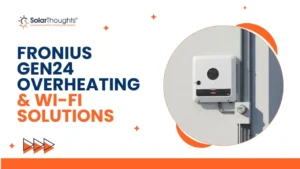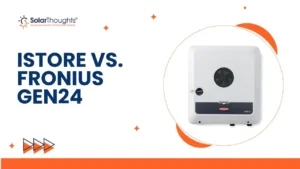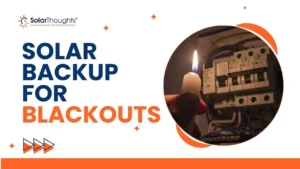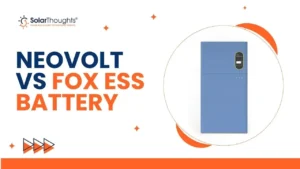At SolarThoughts®, we’ve noticed something concerning. Despite Australia receiving the most solar energy worldwide, over half of residential solar systems aren’t performing as they should. Countless homeowners who’ve invested in clean energy solutions face common solar panel problems daily, such as reduced efficiency, inverter issues, and physical damage to panels. How to fix common solar panel problems often involves regular maintenance checks and timely repairs. The numbers tell a troubling story—about 14% of solar systems develop a major fault every year and stop working completely.
Table of Contents
ToggleThese statistics highlight why understanding solar panel problems is essential for protecting your investment. Inverter malfunctions account for nearly 50% of major failures, while issues like snail trails can reduce your power generation by up to 30%. Your solar panels might be designed to produce energy for 25+ years, but they face numerous challenges that can significantly impact their performance.
We know how frustrating these issues can be when you’ve invested your hard-earned money in solar technology. The good news? Many common solar panel problems can be identified and fixed before they cause serious damage or system failure. We believe in transparency, honest advice, and practical solutions. In this guide, we’ll walk you through the typical issues Brisbane homeowners face and provide straightforward fixes to keep your solar system running efficiently for years to come. Let’s protect your solar investment, one panel at a time.
Most Common Solar Panel Problems
Your solar panel system should require minimal maintenance, but several issues can affect its performance over time. We believe early detection and timely intervention are key to maintaining optimal energy production. Let’s explore the most common problems we see with Brisbane solar installations.
1) Low or No Voltage Output
Your panels should deliver maximum output in optimal weather conditions. When they produce low or zero voltage despite abundant sunshine, something’s definitely wrong. We’ve found that dirty panels, excessive shading, extremely high temperatures, or charge controller issues commonly cause low voltage output. You can diagnose this issue by checking your inverter display for error codes, ensuring circuit breakers are in the “on” position, and using a multimeter to test voltage levels.
2) Snail Trails and Microcracks
We often see brownish discolorations called snail trails appearing on solar panels, typically around cell edges and microcrack areas. These usually develop within several months to years after installation. The trails form when moisture enters through microcracks, causing silver nanoparticles from grid fingers to migrate into the encapsulant. While not immediately destructive, these trails indicate underlying microcracks that can reduce your power generation by up to 30%.
3) PID (Potential Induced Degradation)
PID occurs when high voltage differences between photovoltaic cells and the ground create unwanted electrical leakage currents. We’ve seen this degradation cause power losses of up to 30% or even 40% in severe cases. PID is more common in systems where the negative terminal of the solar array is grounded. The condition worsens with high temperatures and humidity—something Brisbane homeowners should pay particular attention to.
4) Hot Spots and Overheating
Hot spots develop when disruptions occur in your panel’s energy production pathways. These localized overheating areas not only reduce performance but can cause permanent damage to your system. When one cell in a panel is shaded or defective, its electrical output diminishes while the other cells continue generating current. This creates reverse bias, causing the affected cell to heat up excessively. As a result, these hot spots can lead to cell cracking, solder melting, or complete solar cell degradation.
5) Inverter Malfunctions
We find that inverters typically have a shorter lifespan (10-15 years) compared to solar panels (25+ years). Common inverter issues include overheating due to poor ventilation, grid faults causing voltage fluctuations, MPPT tracker problems, and capacity mismatches between panels and inverters. With years of industry experience, we’ve also seen faulty installations where solar panel capacity doesn’t match inverter specifications, significantly reducing system efficiency.
How to Troubleshoot Solar Panel Issues
When your solar system isn’t performing as expected, our team at SolarThoughts® believes in a systematic approach to identify the problem. Following a logical troubleshooting process not only saves time but prevents further damage to your valuable solar investment.
1) Check the inverter display for error codes
Your inverter is the heart of your solar system—and it’s often the first place to look when problems arise. Examine your inverter display for any flashing red or orange lights that might indicate system faults. These warning indicators typically come with specific error codes that pinpoint exactly what’s wrong. For grid-related issues, you might encounter codes like 102 (AC voltage too high), 103 (AC voltage too low), or 107 (AC grid outside permissible limits). We recommend consulting your inverter manual to understand what each code means before taking action.
2) Use a multimeter to test voltage and current
A good multimeter is your best friend when diagnosing electrical issues. To test voltage properly:
- Disconnect the panel from your system to isolate the MC4 connectors
- Set your multimeter to DC voltage mode and connect to positive and negative cables
- Compare your readings with panel specifications—you should see 80-105% of the open-circuit voltage (Voc) in full sunlight
For current testing, switch your multimeter to measure DC amps and connect it to create a short circuit. This measures the maximum current your panel can produce and helps identify potential issues with your cells.
3) Inspect for visible damage or dirt
Take the time for a thorough visual inspection. Look carefully for cracks, discoloration, or physical damage on your panel surfaces. We’ve found that even tiny microcracks—not visible to the naked eye—can cause hot spots or power loss over time. While you’re at it, clean any dirt, leaves, or bird droppings that might be blocking precious sunlight from reaching your panels.
4) Restart the charge controller
If problems persist after these checks, try resetting your charge controller. First, disconnect it from both the battery and solar panel to perform a complete restart. For a hard reset, follow your manufacturer’s instructions to restore factory settings, then reconfigure your preferences. We’ve seen many minor issues resolve with this simple step.
5) Test bypass diodes and wiring
The final step in our troubleshooting process involves examining the junction box and testing bypass diodes, which prevent hot spots when panels are partially shaded. Using your multimeter, a working diode should show low resistance in one direction and high resistance in the opposite direction. Meanwhile, inspect all wiring connections for signs of wear, damage, or loose connections that might be limiting electrical flow. We believe in thorough inspections—they often reveal problems before they become major issues.
6) Preventive Maintenance and Monitoring
At SolarThoughts®, we believe prevention beats reaction every time. Proper maintenance isn’t just a response to problems—it’s your best strategy for avoiding solar panel issues altogether. Our team has helped countless Brisbane homeowners maximize their solar investment through simple, effective maintenance practices.
7) Clean panels regularly to avoid grime buildup
Dirt and debris on your solar panels can slash efficiency by 5-35% depending on your location and conditions. While rain helps clean tilted panels naturally, we recommend professional cleaning twice yearly for optimal performance. For single-story homes, you can use a long-handled, soft-bristled broom to remove accessible debris. Your panels should be gently hosed down (never pressure-washed) if they’re mounted on flat roofs where rain might pool. A proper cleaning can boost efficiency by up to 20%, putting more energy and savings back in your pocket.
8) Install monitoring systems for real-time tracking
We’ve seen how quality monitoring systems serve as early-warning protection for your solar investment. These systems track your energy production, consumption, grid exports, and potential faults. A good monitoring platform alerts you within days if your system goes offline—rather than discovering problems months later when your electricity bill arrives. Our team often recommends advanced systems like Enphase Enlighten with their color-coded virtual displays of your array, helping identify underperforming modules based on energy production comparisons.
9) Ensure proper panel positioning and tilt
Panels installed at angles below 10° can’t self-clean effectively during rainfall and risk water pooling, which eventually penetrates the seals. Horizontal panels collect more dirt and may void warranties, as many manufacturers specify minimum installation angles. We’ve found that proper tilt frames for flat roofs are essential for preventing premature degradation and maintaining warranty coverage.
10) Use high-quality components to reduce risk
We’ve always advised our Brisbane customers that selecting reputable manufacturers rather than the cheapest options significantly reduces failure risks. High-quality components typically require minimal maintenance since solar systems lack moving parts. Disconnect switches are likewise essential safety features that allow safe system isolation during maintenance.
11) Schedule annual professional inspections
Your solar system deserves a yearly check-up. Components exposed to weather deteriorate over time, which is why we recommend professional inspections at least annually. During these visits, our electricians check for damage, test safety switches, verify secure mounting, and clear debris. Systems near oceans or in areas with higher vegetation or dust need more frequent maintenance due to salt deposits and environmental factors. We’re committed to helping your solar investment shine brightly year after year.
When to Call a Professional
At SolarThoughts®, we’re strong advocates for DIY solar maintenance where possible. However, we believe in transparency and honest advice when it comes to recognizing situations that demand professional expertise. Knowing these boundaries keeps both your solar investment and personal safety protected.
1) If electrical issues are suspected
Electrical problems need immediate professional attention. When your circuit breaker trips frequently, this signals deeper electrical issues that could damage your system over time. Never attempt to repair wiring damage yourself – this creates dangerous situations that might result in serious injury or worse. Flickering lights or unexpected power outages often point to underlying issues with your solar installation that need expert diagnosis. Remember, even with mains electricity switched off, your solar system remains energized and poses serious shock risks.
2) When damage is beyond surface-level
Large cracks or shattered panels require replacement by qualified technicians – this isn’t a DIY job. What appears as simple visible damage or dirt might actually indicate more serious underlying issues that only professionals can safely assess. We’ve seen small problems escalate into costly repairs when homeowners attempt fixes beyond their expertise. When you notice physical damage beyond simple surface cleaning, calling in the experts saves money and headaches in the long run.
3) If warranty terms restrict DIY repairs
Your solar panel warranties typically require repairs and maintenance by authorized technicians only. DIY repairs or unauthorized work almost always voids warranty coverage – something we don’t want happening to your investment. Most manufacturer warranties specify professional installation and maintenance throughout the system’s lifespan. For warranty claims, professional assessments provide the necessary documentation, particularly when tracing issues to specific module batches.
4) For PID recovery or inverter replacement
PID (Potential Induced Degradation) recovery requires specialized equipment that most homeowners simply don’t have. Professional PID recovery typically involves installing reversal boxes that apply positive voltage between PV modules and ground during nighttime hours. This specialized process helps conductive ions lost during daytime operation return to the PN junction. For inverter issues, trained professionals can accurately determine whether repairs will solve the problem or if replacement is necessary. They’ll also provide a thorough evaluation of your entire system when installing new inverters.
We believe in empowering homeowners to handle appropriate maintenance tasks, but we equally value your safety and investment protection. When in doubt, reaching out to qualified solar technicians ensures your system continues performing efficiently for years to come.
Conclusion
At SolarThoughts®, we believe your solar panel system represents a significant investment in sustainable energy for your Brisbane home. Throughout this guide, we’ve explored the most common problems affecting solar installations and shared our practical solutions to address them before they escalate into costly repairs.
Regular maintenance remains the cornerstone of optimal solar panel performance. Clean panels, proper positioning, and quality monitoring systems significantly extend your system’s lifespan while maximizing energy production. Though you can handle many minor issues independently, certain problems demand professional intervention, especially those involving electrical components or warranty-covered repairs.
Understanding the warning signs of potential issues empowers you to take timely action. From inverter error codes to visible panel damage, early detection prevents complete system failure. We’ve found that combining proactive maintenance with prompt troubleshooting helps protect your solar investment for decades.
Solar technology continues to evolve, making systems increasingly reliable and efficient. Despite occasional challenges, solar energy remains one of the most sustainable and cost-saving power solutions available today. We’re passionate about helping our customers get the most from their solar systems. With proper care and attention, your solar panels will continue generating clean energy and savings for many years to come. Let’s keep your solar system shining bright, one panel at a time.
FAQs
Q1. How often should I clean my solar panels?
It’s recommended to clean your solar panels at least twice a year. Regular cleaning can boost efficiency by up to 20%, significantly increasing energy production. However, if you live in an area with high dust or pollution levels, more frequent cleaning may be necessary.
Q2. What should I do if my solar panels are producing less energy than usual?
First, check for visible dirt or debris on the panels and clean them if necessary. Then, inspect the inverter display for any error codes. If the issue persists, use a multimeter to test voltage and current. If you’re still unable to identify the problem, it’s best to contact a professional for a thorough inspection.
Q3. Can weather conditions affect my solar panel’s performance?
Yes, weather can impact solar panel efficiency. Extreme heat can reduce output, while snow or heavy cloud cover can temporarily decrease energy production. However, well-designed systems are built to withstand various weather conditions and should perform efficiently over time.
Q4. How long do solar panels typically last?
Solar panels are designed to last 25 years or more. However, their efficiency may gradually decrease over time. Most manufacturers guarantee at least 80% of rated power output after 25 years. Regular maintenance and prompt addressing of issues can help extend their lifespan.
Q5. When should I call a professional for solar panel issues?
You should call a professional if you suspect electrical problems, notice significant physical damage beyond surface-level issues, or if your warranty terms restrict DIY repairs. Additionally, for complex issues like PID (Potential Induced Degradation) recovery or inverter replacement, professional expertise is crucial to ensure proper diagnosis and repair.
Our Popular Services
Top-rated solar panels company in Brisbane | Solar Panel Installation in Gold Coast | Upgrading existing Solar system | Solar Panel Repairs and Maintenance | Solar Panel Cleaning Service | Solar Battery Installations | Solar Inverter Installations






